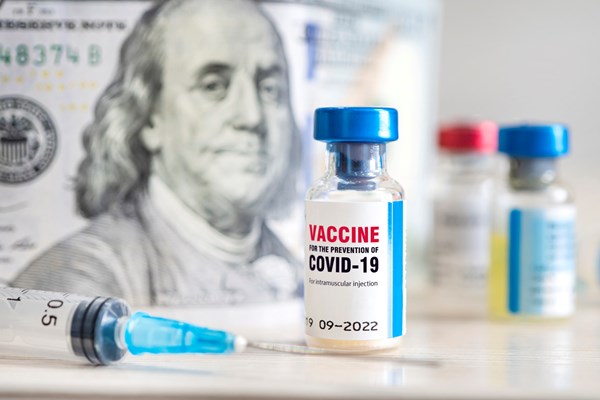COVID Vaccinations Save (a lot of) Lives and Money
As of December 2021, 5.94 million people worldwide were reported to have died of COVID, with an estimated 18.2 million excess deaths due to the systemic health effects of the pandemic. Throughout the pandemic, the financial impacts of COVID infections, hospitalizations, deaths, and workforce disruptions have been widely discussed and have been enormous. Public health interventions like Operation Warp Speed in the United States have invested significant governmental funds into development and distribution of COVID vaccinations. These vaccination campaigns have had enormous impacts on reduction in mortality and health care costs.
A recent paper analyzed the impact of vaccination campaigns on deaths from COVID in the U.S. as of May 2021, five months after initial approval of vaccines. The authors compared vaccine rates by state with COVID death rates, while controlling for fixed differences between them that existed prior to vaccinations. They then estimated the number of COVID deaths that would have occurred in the absence of vaccines based on pre-vaccine trends, and compared deaths under a vaccination and non-vaccination scenario. As of May 9, 2021, COVID deaths in the U.S. totaled 550,000; authors estimate that nearly 140,000 deaths and 3.1 million cases of COVID had been averted in the U.S. due to vaccines, and that vaccines saved between $625 billion and $1.4 trillion solely in terms of reduced mortality, without including reductions in hospitalizations or lost labor hours.
These financial savings greatly outpaced the estimated $18 billion federal investment into vaccine development and distribution through Operation Warp Speed. At the time of submission for publication in July 2021, 49% of the country were considered fully vaccinated (at the time, two doses) and 56% had received at least one vaccine. Broad vaccination campaigns resulted in significant reductions in both mortality from COVID and total cases of COVID, with correspondingly significant financial savings relative to the investment into vaccines.
Physicians should advocate both locally and broadly for investment into community vaccination and public health efforts to combat evolving infectious diseases as a safe and cost-effective way of saving lives, reducing societal costs, and reducing the burden on the health care system. The government’s financial investment into vaccines is best recouped when vaccination policies result in decreased infections, hospitalizations, and deaths.
Abstract
ARTICLE: Gupta S, Cantor J, Simon, KI, Bento AK, Wing C, Whaley CM. Vaccinations against COVID-19 may have averted up to 140,000 deaths in the United States. Health Aff (Millwood). 2021; 40(9):1465-1472.
COVID-19 vaccination campaigns continue in the United States, with the expectation that vaccines will slow transmission of the virus, save lives, and enable a return to normal life in due course. However, the extent to which faster vaccine administration has affected COVID-19-related deaths is unknown.
We assessed the association between U.S. state-level vaccination rates and COVID-19 deaths during the first five months of vaccine availability. We estimated that by May 9, 2021, the U.S. vaccination campaign was associated with a reduction of 139,393 COVID-19 deaths. The association varied in different states. In New York, for example, vaccinations led to an estimated 11.7 fewer COVID-19 deaths per 10,000, whereas Hawaii observed the smallest reduction, with an estimated 1.1 fewer deaths per 10,000.
Overall, our analysis suggests that the early COVID-19 vaccination campaign was associated with reductions in COVID-19 deaths.
As of May 9, 2021, reductions in COVID-19 deaths associated with vaccines had translated to value of statistical life benefit ranging between $625 billion and $1.4 trillion.
EMRA + PolicyRx Health Policy Journal Club: A collaboration between Policy Prescriptions and EMRA
 As emergency physicians, we care for all members of society, and as such have a unique vantage point on the state of health care. What we find frustrating in our EDs - such as inadequate social services, the dearth of primary care physicians, and the lack of mental health services - are universal problems. As EM residents and fellows, we learn the management of myocardial infarctions and traumas, and how to intubate, but we are not taught how health policy affects all aspects of our experience in the ED. Furthermore, given our unique position in the health care system, we have an incredible opportunity to advocate for our patients, for society, and for physicians. Yet, with so many competing interests vying for our conference education time, advocacy is often not included in the curricula. This is the gap this initiative aims to fill. Each month, you will see a review of a new health policy article and how it is applicable to emergency physicians.
As emergency physicians, we care for all members of society, and as such have a unique vantage point on the state of health care. What we find frustrating in our EDs - such as inadequate social services, the dearth of primary care physicians, and the lack of mental health services - are universal problems. As EM residents and fellows, we learn the management of myocardial infarctions and traumas, and how to intubate, but we are not taught how health policy affects all aspects of our experience in the ED. Furthermore, given our unique position in the health care system, we have an incredible opportunity to advocate for our patients, for society, and for physicians. Yet, with so many competing interests vying for our conference education time, advocacy is often not included in the curricula. This is the gap this initiative aims to fill. Each month, you will see a review of a new health policy article and how it is applicable to emergency physicians.



